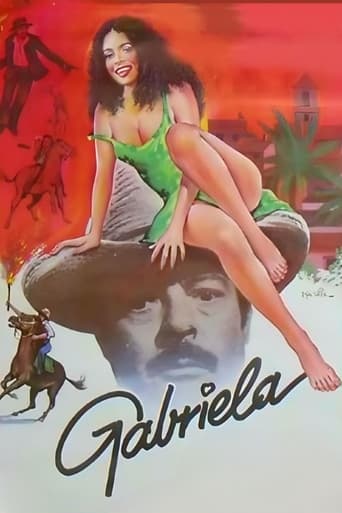

Very Cool!!!
... View MoreSlow pace in the most part of the movie.
... View MoreThere is just so much movie here. For some it may be too much. But in the same secretly sarcastic way most telemarketers say the phrase, the title of this one is particularly apt.
... View MoreStory: It's very simple but honestly that is fine.
... View MoreNow that I have finished watching the soap opera Gabriela (2012) based on the 1958 Jorge Amado's novel "Gabriela, Cravo e Canela", I felt some curiosity to also watch this movie, filmed in 1983 and based in the same novel.This movie was a consequence of the success of the first Gabriela adaptation to the screen. In fact, in 1975, this novel by Jorge Amado was adapted for the first time to a TV show and this soap opera was a tremendous success either in Brazil and Portugal (and many other countries as well, later).So, a few years later, 1983, "Gabriela, Cravo e Canela" was adapted to cinema by Bruno Barreto. The actress playing the main role, GABRIELA, is the same of the first soap opera, Sonia Braga, and to play NACIB (another important character in the plot) a great figure of the seventh art was called: Marcello Mastroianni! So, as we can see, the cast to this film was not bad, at all! However, it's a movie, with just one hour and half to tell a story like Gabriela, so, many characters present in the original novel were cut or had minimal roles. In the soap opera it was different of course, the plot was extended and all the characters were detailed built and described. I haven't totally read the original novel but by what I know of it, the 2012 soap opera even create some new characters and subplots focused on them (the character Lindinalva for instance). So, watching the movie, at parts I felt that one hour and half was just too short to describe this story as it deserves. Some scenes felt as they were hardly justified. At parts it seems that just one person that already knows the plot will understand their actions! Nevertheless the chronology of the events is more accurate to the original novel than in the soap opera. In fact it begins were the novel begins (the murder of DONA SINHAZINHA) and follows the same line of the novel until the end. But there's an important detail: this film is focused essentially on the GABRIELA and NACIB romance and not on the subplot about politics which was also very important in the novel. In fact characters like CORONEL RAMIRO BASTOS and MUNDINHO FALCAO are relegated to a secondary plan and have little importance in the movie's plot.I guess it might have been a choice of the director: tell this story on the sensual and romantic side and putting the subplot of politics and social criticism to a secondary plan. In fact, as I said before, one hour and half is too short to deeply describe both plots, so he decided to go deeper on the romance and sensuality OK, it was a choice and we can't complain, especially when we see Sonia Braga Another feature that is certainly more accurate in this film than in the recent soap opera is the description of Ilhéus and all the settings. Back to 1925 a city like Ilhéus would certainly look like it's portrayed in this film, rather than it is in the 2012 soap opera (not to mention the cabaret Bataclan, which is not described in the movie but it's portrayed like the cabaret of the film MOULIN ROUGE in the soap opera!).So, this adaption of "Gabriela, Cravo e Canela" is mostly a sensual romance, a story focused essentially on NACIB and GABRIELA. The film is entertaining and the actors do a good job, I just think it ends being too short as I said before. I felt that plenty of their actions are hardly explained and one that doesn't already know about the novel's plot won't understand many of their actions.
... View MoreThis was celebrated in its day. Probably most of it had to do with Sónia Braga being here.In fact we have a combination that make the thing worthwhile: Tom Jobim and Jorge Amado. They are part of a recent creative Brazilian tradition, which consists in throwing interesting concepts into popular forms, things that people can recognize and identify to, as "pop" but which in fact is the work of intellectual creative minds. That's why we have "música popular brasileira" (brazilian 'pop' music), which contains bossa nova, which is in fact a branch fully developed by intellectual minds, with empathy for popular expressions. Jorge Amado does a similar thing with literature. He writes material that is soap-operish (and in fact was and is fully adapted into TV minor things)but at the same time works words and builds his own language, which flows on your ears as fluid as bossa nova (even if you don't understand Portuguese, try and hear it, you'll get what i mean).These ability to be deep and popular at the same time is the biggest quality of Jobim and Amado, to me. The problem is that these minds can very easily be misunderstood, and taken for granted in what they mean, if the minds that interpret them and thin. So i admire this film, because people in it understood this. Not that this is fully achieved, on any matter. Sometimes it sounds half-baked, and the kind of explicit sexuality with no explicit sex it tries to depict is something so much explored in the last 25 years that this sounds very dated now.Also, i don't think Braga would explode now as she did than, sexual conceptions for the Latin woman (preconcepcions)have evolved to someone who is both sensual and intellectual (Alice Braga, Sónia's niece is probably a good example). Sónia plays a rural type, she's spontaneous, has unshaved underarms, she's illiterate, she exists in the film for the sexual frictions and tensions she causes.Well, sex is the core of Amado's writing. He chooses a close conservative environment, a kind of social still water, and throws a stone into that water (Braga). So she, through unconscious sensuality, commands the game, and moves the plot. Since they wanted to explore Sonia's effect in those days public, this is a terribly effective device (something like what is happening in a domestic scale with Soraia Chaves, in Portugal these days).Complaints: Barreto has a good cinematic eye, and he works visually his shots and i appreciate that, but he was not sure whether he wanted to make a film about Sonia Braga and what moves around her or a film about a sensual woman in a closed village. I think he tried to mix both, and that's the failure. I'll get to his "Dona Flor...", same context, Amado and Braga as well, and see what he did there. Also, they avoided trying to explain why Gabriela, being so much in love, would screw another man, mostly being Mastroianni's best friend. We have a small clue, but it's not conclusive. It's 'just' a plot hole and i don't value that usually, but here it felt bad, it was important the insight on Gabriela.A side note: i have a special interest in Portuguese colonial urbanism. I'm actually working right now on a final thesis on one of those cities, one of the best (ilha de Moçambique). This little city depicted (Parati, not Ilhéus) looks a good example as well, which apparently was heavily influenced by masonry in its conception. Watch the film on that matter alone, if you're interested in the theme. Some shots are really worth it.My opinion: 3/5http://www.7eyes.wordpress.com
... View MoreGabriela is a great romance by Jorge Amado, a great Brazilian writer. In 1975 it was adapted to TV novel. It was very successful and we could see a young Sonia Braga at the beginning of her career. Years later we could see Sonia again but she was not young anymore. But her talent was much better. The movie only shows sexy scenes and the political history was on the second hand unfortunately. But there was a present for us. We could see in a short time a great Brazilian actress called Maria Zenaide, with her beautiful eyes making a little participation. On the other hand we could see her again and we could ask where are the great actresses of Brazil ? Unfortunately Brazil is a country with no memory and only shows what the directors think are good. Thanks God we can see Maria Zenaide making educacional commercial and she still sings Brazilian Songs though her band Grupo Avelloz, with good singers and musicians: Will Tom and Teresa Carvalho(both from Dama de Paus band), Jorge Som and Chaguinha Lima(from Siri Atômico band).
... View MoreGabriela, Clove & Cinnamon was the novel which marked Jorge Amado's break from pure class warfare--he received several Stalin prizes in his early career!--and embrace of the joys of Brazilian humanity. Sonia Braga has starred in adaptations of three of Amado's novels, all of them magnificent (the other two are Dona Flor and Tieta). I won't say she is here at her sexiest--Sonia Braga is sexy any time she's on screen--but this is one of her best movies, helped much by the other players, among them, curiously, Marcello Mastrioanni as the Syrian immigrant who hires Gabriela as cook and quickly finds himself in a deeper relationship. The plot here involves attitudes toward women and their sexuality, an eventual welcome breakdown of the double standard. and progress of law and order in a society too often ruled by lawlessness and custom. Amado dies without getting a Nobel Prize for Literature: Gabriela and the other two films mentioned convincingly demonstrate why he should have won it.
... View More